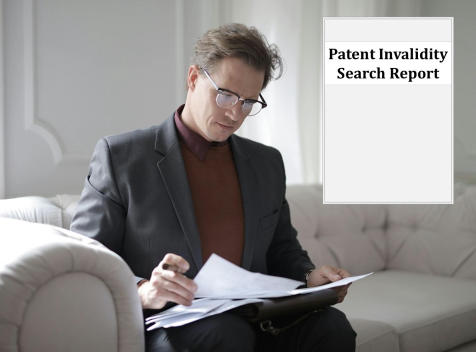When and How Patent Invalidity Searches Are Used?
Table of Contents
- When and How Patent Invalidity Searches Are Used?
-
When Are Patent Invalidity Searches Used?
- 1. When a Company Receives a Patent Infringement Notice
- 2. Before Negotiating a Patent License
- 3. Before Acquiring or Investing in a Patent Portfolio
- 4. Before Filing a Patent Infringement Lawsuit
- 5. During Patent Litigation (Defensive Strategy)
- 6. During Post-Grant Proceedings (IPR, PGR, and Opposition Proceedings)
- 7. To Prevent Patent Assertion by Patent Trolls
- How Are Patent Invalidity Searches Conducted?
- Why Patent Invalidity Searches Are Crucial
- Why an Invalidity Search Is a High-ROI Investment
- Experience the Power of a Comprehensive Invalidity Search— Without any Risk
- Who Can Benefit from This Pilot Search?
- You may reach us with your requirement with this form
-
When Are Patent Invalidity Searches Used?
Patent invalidity searches play a critical role in intellectual property (IP) strategy, particularly when a business or individual is facing patent disputes, infringement claims, or licensing negotiations. These searches help uncover prior art that can be used to challenge the validity of a granted patent, potentially avoiding costly settlements, licensing fees, or legal penalties.
In this article, we will discuss when patent invalidity searches are used and how they are conducted, with real-life examples that illustrate their significance.
When Are Patent Invalidity Searches Used?
A patent invalidity search is typically conducted in the following seven key situations:
1. When a Company Receives a Patent Infringement Notice
One of the most common reasons for conducting a patent invalidity search is when a company receives a cease-and-desist letter or a patent infringement lawsuit. If another party claims that you are infringing on their patent, your best defense may be to invalidate that patent by proving that relevant prior art existed before the patent was granted.
Example: Samsung vs. Apple (2011-2018) – The Smartphone Wars
Apple sued Samsung for patent infringement, claiming that Samsung’s smartphones copied Apple’s iPhone design and features. To counter Apple’s claims, Samsung conducted an extensive patent invalidity search to identify prior art that predated Apple’s patents.
By presenting this prior art, Samsung was able to partially invalidate some of Apple’s patent claims, significantly reducing the damages it had to pay.
Key Takeaway: If you receive an infringement notice, conducting an invalidity search can help challenge the patent’s legitimacy and strengthen your legal defense.
2. Before Negotiating a Patent License
If a company is forced to license a patent from another entity, an invalidity search can be used to assess whether the patent is truly valid. If strong prior art is found, the company may negotiate lower licensing fees or avoid licensing altogether.
Example: Blackberry vs. Qualcomm (2017) – $940 Million in Overpaid Royalties
Blackberry was paying hundreds of millions of dollars in licensing fees to Qualcomm for cellular patents. However, Blackberry later conducted patent validity investigations and discovered that some of the patents were not as strong as originally believed. This discovery allowed Blackberry to negotiate and recover $940 million in overpaid royalties.
Key Takeaway: If your business is considering paying for a patent license, conducting an invalidity search can save millions in unnecessary fees.
3. Before Acquiring or Investing in a Patent Portfolio
Investors and companies that buy patents or invest in intellectual property portfolios conduct invalidity searches to ensure that the patents they are acquiring are strong and enforceable.
Example: Google’s Acquisition of Motorola’s Patent Portfolio (2011 – $12.5 Billion Deal)
Google purchased Motorola Mobility for $12.5 billion, largely for its 17,000 patents related to mobile technology. However, after acquiring the portfolio, Google found that many of these patents were weak or easily challenged with prior art. This led to lower-than-expected returns on the investment.
Key Takeaway: Before acquiring a patent portfolio, an invalidity search can help ensure that the patents truly hold value.
4. Before Filing a Patent Infringement Lawsuit
If a company is planning to sue a competitor for patent infringement, conducting an invalidity search first is crucial. This ensures that the patent is strong and can withstand challenges in court.
Example: Microsoft vs. Barnes & Noble (2011) – Failed Patent Lawsuit
Microsoft sued Barnes & Noble over patents related to tablet and e-reader technology. However, during the litigation, Barnes & Noble’s legal team discovered prior art that significantly weakened Microsoft’s patent claims. As a result, Microsoft withdrew the lawsuit and later settled the dispute outside of court.
Key Takeaway: Before suing for patent infringement, companies should conduct invalidity searches to ensure that their patent claims will hold up in court.
5. During Patent Litigation (Defensive Strategy)
If a company is already involved in active litigation, an invalidity search can be used as a defensive strategy to challenge the opposing party’s patent.
Example: Google vs. Oracle (2010-Present) – Java API Copyright Dispute
Google and Oracle have been in a long-running legal battle over the use of Java APIs in the Android operating system. Google conducted multiple patent invalidity searches to find prior art that could weaken Oracle’s claims. This helped Google defend itself against billion-dollar damages.
Key Takeaway: If you are in a patent lawsuit, an invalidity search can uncover weaknesses in the opposing party’s patent claims.
6. During Post-Grant Proceedings (IPR, PGR, and Opposition Proceedings)
After a patent has been granted, it can still be challenged through post-grant proceedings such as:
- Inter partes review (IPR) – A process to challenge a U.S. patent based on prior art.
- Post-grant review (PGR) – A broader review process available for newly granted patents.
- Opposition proceedings – Used in Europe, India, and other jurisdictions to challenge a patent after it is granted.
Example: Apple’s IPR Challenges Against Qualcomm Patents (2018)
Apple filed multiple Inter Partes Review (IPR) petitions against Qualcomm’s patents related to wireless technology. Apple’s patent invalidity searches helped it find prior art, leading to the cancellation of several Qualcomm patents.
Key Takeaway: If you want to challenge a patent after it has been granted, an invalidity search can provide the evidence needed for IPR or opposition proceedings.
7. To Prevent Patent Assertion by Patent Trolls
Patent assertion entities (PAEs), also known as patent trolls, acquire patents and aggressively sue companies for infringement—often without having any real products or innovation of their own. Many companies conduct patent invalidity searches to fight back against patent trolls.
Example: Newegg vs. Soverain Software (2013) – Beating a Patent Troll
Soverain Software, a well-known patent troll, sued Newegg for allegedly infringing on an “online shopping cart” patent. Instead of settling, Newegg conducted a patent invalidity search, finding strong prior art that invalidated Soverain’s patent. This victory saved Newegg millions in damages.
Key Takeaway: If your company is facing a lawsuit from a patent troll, an invalidity search can help eliminate their claims entirely.
How Are Patent Invalidity Searches Conducted?
A patent invalidity search involves:
- Understanding the target patent – Carefully analyzing the claims, specifications, and prosecution history.
- Searching multiple databases – Patent databases such as USPTO, EPO, WIPO, and national patent offices.
- Reviewing non-patent literature (NPL) – Academic papers, technical journals, product catalogs, and conference proceedings.
- Using foreign language searches – Looking for prior art in Japanese, Chinese, European, and other non-English sources.
- Analyzing search results – Identifying prior art that is most relevant to the patent claims.
- Preparing an invalidity report – Documenting the prior art findings and how they impact the target patent.
Why Patent Invalidity Searches Are Crucial
Patent invalidity searches are a powerful tool in patent strategy, helping companies:
- Avoid costly infringement lawsuits
- Negotiate better licensing terms
- Challenge weak patents in litigation
- Defend against patent trolls
- Ensure valuable investments in patents
A well-executed invalidity search can mean the difference between paying millions in damages or avoiding liability entirely. If your business is facing a patent dispute, an invalidity search could be your strongest weapon.
Why an Invalidity Search Is a High-ROI Investment

A well-executed invalidity search can mean the difference between:
✔ Winning vs. Losing a Patent Litigation – A single overlooked piece of prior art can make or break a case, saving millions in damages and legal fees.
✔ Gaining vs. Losing Negotiation Leverage – Invalidating a competitor’s patent before entering a licensing or infringement dispute can shift the power dynamics in your favor.
✔ Securing vs. Risking Market Freedom – Before launching a product, knowing whether an asserted patent is truly valid can prevent unnecessary licensing fees or redesign costs.
Simply put, an invalidity search is not an expense—it’s an investment with the potential for significant financial and strategic returns. However, we know that you may want to validate the quality of our work before committing to long-term projects.
Experience the Power of a Comprehensive Invalidity Search— Without any Risk
When it comes to patent litigation, licensing, and enforcement, every legal argument, business decision, and competitive strategy hinges on the strength—or weakness—of a patent.
At Patent Attorney Worldwide Pvt. Ltd., we specialize in conducting highly strategic patent invalidity searches that uncover critical prior art—often the key to nullifying a competitor’s patent, avoiding costly litigation, or gaining leverage in negotiations.
We understand that choosing a reliable partner for invalidity searches is a critical decision—one that must be based on results, not just promises. That’s why we are offering you an opportunity to experience our expertise through a risk-free pilot project—at the very minimum cost, that is no-profit costs.
Here’s how it works:
- Pilot Search at Minimum Cost – You get a comprehensive invalidity search at the lowest possible cost, ensuring no financial risk in evaluating our expertise.
- Full-Scale Research & Analysis – Unlike generic or automated searches, our manual deep-dive approach ensures we uncover even the most obscure prior art, whether from patents, non-patent literature, or global databases.
- Strategic & Actionable Insights – We don’t just provide a list of references; we analyze, categorize, and map prior art to show why a claim is invalid and how it can be effectively used in litigation or negotiations.
- No Obligation, Just Results – If our search delivers the value we promise (as we are confident it will), we can discuss regular engagements. If not, you still walk away with a top-tier search at near-cost pricing—with no further commitment.
Who Can Benefit from This Pilot Search?
- Law firms & patent litigators looking for a trusted partner in high-stakes patent invalidity cases.
- Corporations & in-house counsel needing a solid prior art strategy before licensing, product launches, or legal disputes.
- Entrepreneurs, inventors, and professionals requiring a high-quality invalidity search to safeguard their interests.
Feel free to contact us for your questions or concerns, we would be happy to answers all of your questions. We can get started with a pilot invalidity search project and let the results speak for themselves.
Let’s work together to uncover prior arts that makes an impact.
